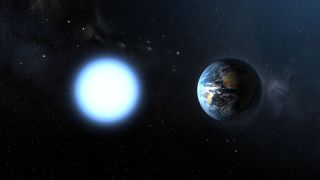
White dwarfs would be roughly the same size as any potentially habitable planets that might orbit them.
(Image credit: NASA and ESA)
Planets could survive the death of their star and become capable of supporting life — and now astronomers are going to go hunting for them.
Stars do not survive forever, the sun included. In about five billion years, Earth’s star will begin to exhaust its supply of hydrogen used to generate energy via nuclear fusion in its core. The sun’s core will then begin to contract, increasing the temperature so that hydrogen in its outer envelope can then ignite fusion reactions that will cause the sun — and other stars like it, when they reach this stage — to expand into a red giant.
The red giant phase is bad news for any planets nearby. In our solar system, the expanding sun will swallow up Mercury, Venus and probably Earth, too.
Planets farther out will fare better. Worlds that are five to six times farther from their star than Earth is from the sun will be warmed by the expanding star, melting their ice and forming surface oceans and, potentially, life. In our solar system, Jupiter’s icy moons, such as Europa and Ganymede, would be in such prime position.
Related: Alien life could be detectable on planets around dying stars
But it’s a fine thing. Too close, and their water will evaporate. Too far out, and the worlds will remain frozen. In essence, the Goldilocks zone of habitability will move out from an expanding star, and a planet or icy moon will have to inhabit this zone to have any chance of developing liquid water.
The red giant star will continue to evolve. Eventually, all fusion reactions will cease, and the star’s puffy outer layers will be expelled, leaving behind only the star’s compact core, known as a white dwarf.
Breaking space news, the latest updates on rocket launches, skywatching events and more!
White dwarfs are born hot and shine brightly, but they are also tiny, about the size of Earth. Their small size means that they don’t radiate much heat in total. A planet orbiting one of these exotic objects would need to be about 930,000 miles (1.5 million kilometers) from the white dwarf — about 1% of the distance from Earth to the sun — to be warm enough to host liquid water.
Therein lies the problem. All the nearby planets would have been deep fried and swallowed long ago, and the outer planets and moons that have now melted will be too far away from the white dwarf to support surface water.
So, how can one transfer a planet from hundreds of millions of kilometers away to the new, close-in Goldilocks zone?
“It is a perilous journey,” said Juliette Becker of the University of Wisconsin-Madison in a statement. She noted that it is “difficult for oceans to survive this process, but it is possible.”
Becker, who discussed how exoplanets could survive this process and subsequently be detected via “transits” — passages across their host star’s face, from our perspective — at the 244th meeting of the American Astronomical Society earlier in June, explained that the mechanism for moving a planet closer to a white dwarf is called tidal migration.
“In tidal migration, some dynamical instability between planets in the system puts one of them into a high-eccentricity orbit, like a comet, where it swings in really close to the central body in the system and then far out again.”
The migrating planet doesn’t stay in this comet-like orbit for long. Gravity acts to circularize its path, keeping the planet close to the white dwarf. And it is here where astronomers could spot their transits.
One caveat is that white dwarfs don’t seem to be a hotbed of exoplanetary action. Earlier this year, the James Webb Space Telescope (JWST) observed two planet candidates around white dwarfs, but on the whole they have been scarce. Neither of these candidates transits its white dwarf.
If a planet does transit its white dwarf, then transit spectroscopy — watching for the planet’s atmosphere absorbing and filtering out certain wavelengths of starlight during a transit — could reveal the presence of water in that planet’s atmosphere. Such measurements have been made for exoplanets transiting regular stars, but it might actually prove easier to do so with a white dwarf.
“White dwarfs are so small and so featureless that if a terrestrial planet transited in front of them, you could actually do a much better job of characterizing its atmosphere,” said Becker. “The planet’s atmosphere would have a much larger, clearer signal because a larger fraction of the light you’re seeing is passing through exactly what you want to study.”
Water isn’t a guarantee of life, of course, but even the possibility that previously frozen worlds could be rendered habitable by the death of their star, and then be pulled into a close orbit around that dead star where they can remain habitable, gives astrobiologists a new arena in which to consider alien life. Such a world would be the ultimate case of a “phoenix” world, and prove that there can be life after stellar death.
Becker has a paper describing her work studying the search for habitable planets transiting white dwarfs currently under peer review.
Join our Space Forums to keep talking space on the latest missions, night sky and more! And if you have a news tip, correction or comment, let us know at: community@space.com.
Keith Cooper is a freelance science journalist and editor in the United Kingdom, and has a degree in physics and astrophysics from the University of Manchester. He’s the author of “The Contact Paradox: Challenging Our Assumptions in the Search for Extraterrestrial Intelligence” (Bloomsbury Sigma, 2020) and has written articles on astronomy, space, physics and astrobiology for a multitude of magazines and websites.
>>> Read full article>>>
Copyright for syndicated content belongs to the linked Source : Space.com – https://www.space.com/white-dwarf-habitable-planets-migration
